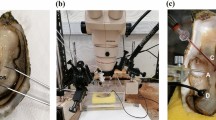Abstract
A capillary assay was employed to quantify positive chemotactic responses in the motile, unicellular, marine algaDunaliella tertiolecta. Among a wide range of inorganic and organic compounds tested, only ammonium ion,l-tyrosine,l-tryptophan, andl-phenylalanine were found to be major atractants for the chlorophyte.l-Methionine andl-cysteine weakly attracted the alga at 10−3 M. The minimum concentration of the major attractants needed to elicit an observable chemotactic response was approximately 10−6 M. The maximum response occurred when the capillaries contained 10−5 Ml-tyrosine orl-tryptophan, 10−4 Ml-phenylalanine, and 10−3 M ammonium chloride. The other amino acids, carbohydrates, B-vitamins, urea, and nitrate were among the chemicals that failed to attractD. tertiolecta. The alga apparently possesses one chemoreceptor that binds ammonium ion only, and another chemoreceptor that binds the three aromatic amino acids.
Similar content being viewed by others
Literature Cited
Chet, I., Mitchell, R. 1976. Ecological aspects of microbial chemotactic behavior. Annual Review of Microbiology30:221–239.
de Jong, M. H., van der Drift, C., Vogels, G. D. 1975. Receptors for chemotaxis inBacillus subtilis. Journal of Bacteriology123:824–827.
Eppley, R. W., Rogers, J. N., McCarthy, J. J. 1969. Halfsaturation constants for uptake of nitrate and ammonium by marine phytoplankton. Limnology and Oceanography14:912–920.
Gooday, G. W. 1975. Chemotaxis and chemotropism in fungi and algae, pp. 154–204. In: Carlile, M. J. (ed.) Primitive sensory and communication systems. The taxes and tropisms of microorganisms and cells. London, New York, San Francisco: Academic Press.
Hellebust, J. A. 1970. The uptake and utilization of organic substances by marine phytoplankters, pp. 225–256. In: Hood, D. W. (ed.), Organic matter in natural waters, Occasional Publication No. 1. Institute of Marine Science, University of Alaska.
Levandowsky, M., Hauser, D. C. R. 1978. Chemosensory responses of swimming algae and protozoa, pp. 145–210. In: Bairne, G. H., Danielli, J. F. (eds.), International Review of Cytology, New York, San Francisco, London: Academic Press.
Loeblich, A. R., Smith, V. E. 1968. Chloroplast pigments of the marine dinoflagellateGyrodinum resplendens. Lipids3:5–13.
Mesibov, R., Adler, J. 1972. Chemotaxis toward amino acids inEscherichia coli. Journal of Bacteriology112:315–326.
Palleroni, N. J. 1976. Chamber for bacterial chemotaxis experiments. Applied and Environmental Microbiology32:729–730.
Sjoblad, R. D., Chet, I., Mitchell, R. 1979. A quantitative assay for algal chemotaxis. Applied and Environmental Microbiology, in press.
Author information
Authors and Affiliations
Rights and permissions
About this article
Cite this article
Sjoblad, R.D., Chet, I. & Mitchell, R. Chemoreception in the green algaDunaliella tertiolecta . Current Microbiology 1, 305–307 (1978). https://doi.org/10.1007/BF02601688
Issue Date:
DOI: https://doi.org/10.1007/BF02601688




